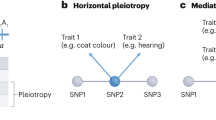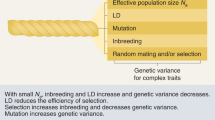Abstract
For many traits, including susceptibility to common diseases in humans, causal loci uncovered by genetic-mapping studies explain only a minority of the heritable contribution to trait variation. Multiple explanations for this ‘missing heritability’ have been proposed1. Here we use a large cross between two yeast strains to accurately estimate different sources of heritable variation for 46 quantitative traits, and to detect underlying loci with high statistical power. We find that the detected loci explain nearly the entire additive contribution to heritable variation for the traits studied. We also show that the contribution to heritability of gene–gene interactions varies among traits, from near zero to approximately 50 per cent. Detected two-locus interactions explain only a minority of this contribution. These results substantially advance our understanding of the missing heritability problem and have important implications for future studies of complex and quantitative traits.
This is a preview of subscription content, access via your institution
Access options
Subscribe to this journal
Receive 51 print issues and online access
$199.00 per year
only $3.90 per issue
Buy this article
- Purchase on SpringerLink
- Instant access to full article PDF
Prices may be subject to local taxes which are calculated during checkout





Similar content being viewed by others
Change history
19 February 2013
A minor change was made to the Online Methods section.
References
Manolio, T. A. et al. Finding the missing heritability of complex diseases. Nature 461, 747–753 (2009)
Hill, W. G. Understanding and using quantitative genetic variation. Phil. Trans. R. Soc. Lond. B 365, 73–85 (2010)
Mackay, T. F. C., Stone, E. A. & Ayroles, J. F. The genetics of quantitative traits: challenges and prospects. Nature Rev. Genet. 10, 565–577 (2009)
Buckler, E. S. et al. The genetic architecture of maize flowering time. Science 325, 714–718 (2009)
Atwell, S. et al. Genome-wide association study of 107 phenotypes in Arabidopsis thaliana inbred lines. Nature 465, 627–631 (2010)
Mackay, T. F. et al. The Drosophila melanogaster Genetic Reference Panel. Nature 482, 173–178 (2012)
Aylor, D. L. et al. Genetic analysis of complex traits in the emerging Collaborative Cross. Genome Res. 21, 1213–1222 (2011)
Rockman, M. V. The QTN program and the alleles that matter for evolution: all that’s gold does not glitter. Evolution 66, 1–17 (2012)
Goldstein, D. B. Common genetic variation and human traits. N. Engl. J. Med. 360, 1696–1698 (2009)
Yang, J. et al. Common SNPs explain a large proportion of the heritability for human height. Nature Genet. 42, 565–569 (2010)
Visscher, P. M., Brown, M. A., McCarthy, M. I. & Yang, J. Five years of GWAS discovery. Am. J. Hum. Genet. 90, 7–24 (2012)
Pritchard, J. K. Are rare variants responsible for susceptibility to complex diseases? Am. J. Hum. Genet. 69, 124–137 (2001)
Zuk, O., Hechter, E., Sunyaev, S. R. & Lander, E. S. The mystery of missing heritability: genetic interactions create phantom heritability. Proc. Natl Acad. Sci. USA 109, 1193–1198 (2012)
Falconer, D. S. & Mackay, T. F. C. Introduction to Quantitative Genetics edn 4 (Longman, 1996)
Eichler, E. E. et al. Missing heritability and strategies for finding the underlying causes of complex disease. Nature Rev. Genet. 11, 446–450 (2010)
Ehrenreich, I. M., Gerke, J. P. & Kruglyak, L. Genetic dissection of complex traits in yeast: insights from studies of gene expression and other phenotypes in the BY×RM cross. Cold Spring Harb. Symp. Quant. Biol. 74, 145–153 (2009)
Brem, R. B. & Kruglyak, L. The landscape of genetic complexity across 5,700 gene expression traits in yeast. Proc. Natl Acad. Sci. USA 102, 1572–1577 (2005)
Ehrenreich, I. M. et al. Dissection of genetically complex traits with extremely large pools of yeast segregants. Nature 464, 1039–1042 (2010)
Ruderfer, D. M., Pratt, S. C., Seidel, H. S. & Kruglyak, L. Population genomic analysis of outcrossing and recombination in yeast. Nature Genet. 38, 1077–1081 (2006)
Visscher, P. M. et al. Assumption-free estimation of heritability from genome-wide identity-by-descent sharing between full siblings. PLoS Genet. 2, e41 (2006)
Orr, H. A. Adaptation and the cost of complexity. Evolution 54, 13–20 (2000)
Storey, J. D., Akey, J. M. & Kruglyak, L. Multiple locus linkage analysis of genomewide expression in yeast. PLoS Biol. 3, e267 (2005)
Brem, R. B., Storey, J. D., Whittle, J. & Kruglyak, L. Genetic interactions between polymorphisms that affect gene expression in yeast. Nature 436, 701–703 (2005)
Dowell, R. D. et al. Genotype to phenotype: a complex problem. Science 328, 469 (2010)
Hill, W. G., Goddard, M. E. & Visscher, P. M. Data and theory point to mainly additive genetic variance for complex traits. PLoS Genet. 4, e1000008 (2008)
Maller, J. et al. Common variation in three genes, including a noncoding variant in CFH, strongly influences risk of age-related macular degeneration. Nature Genet. 38, 1055–1059 (2006)
Lango Allen, H. et al. Hundreds of variants clustered in genomic loci and biological pathways affect human height. Nature 467, 832–838 (2010)
Tennessen, J. A. et al. Evolution and functional impact of rare coding variation from deep sequencing of human exomes. Science 337, 64–69 (2012)
Keinan, A. & Clark, A. G. Recent explosive human population growth has resulted in an excess of rare genetic variants. Science 336, 740–743 (2012)
Nelson, M. R. et al. An abundance of rare functional variants in 202 drug target genes sequenced in 14,002 people. Science 337, 100–104 (2012)
Amberg, D. C., Burke, D. & Strathern, J. N. Methods in Yeast Genetics: a Cold Spring Harbor Laboratory Course Manual (Cold Spring Harbor Laboratory Press, 2005)
R Development Core Team. R: A Language and Environment for Statistical Computing (R Foundation for Statistical Computing, 2012)
Li, H. & Durbin, R. Fast and accurate short read alignment with Burrows–Wheeler transform. Bioinformatics 25, 1754–1760 (2009)
Li, H. et al. The Sequence Alignment/Map format and SAMtools. Bioinformatics 25, 2078–2079 (2009)
Broman, K. W., Wu, H., Sen, S. & Churchill, G. A. R/qtl: QTL mapping in experimental crosses. Bioinformatics 19, 889–890 (2003)
Abramoff, M. D., Magalhaes, P. J. & Ram, S. J. Image Processing with ImageJ. Biophotonics International 11, 36–42 (2004)
Pau, G., Fuchs, F., Sklyar, O., Boutros, M. & Huber, W. EBImage—an R package for image processing with applications to cellular phenotypes. Bioinformatics 26, 979–981 (2010)
Loader, C. locfit: Local Regression, Likelihood and Density Estimation http://CRAN.R-project.org/package=locfit (2012)
Bates, D., Maechler, M. & Bolker, B. lme4: Linear Mixed-Effects Models Using S4 Classes http://CRAN.R-project.org/package=lme4 (2011)
Lee, S. H., Wray, N. R., Goddard, M. E. & Visscher, P. M. Estimating missing heritability for disease from genome-wide association studies. Am. J. Hum. Genet. 88, 294–305 (2011)
Endelman, J. B. Ridge regression and other kernels for genomic selection with R package rrBLUP. Plant Genome 4, 250–255 (2011)
Visscher, P. M. Variation of estimates of SNP and haplotype diversity and linkage disequilibrium in samples from the same population due to experimental and evolutionary sample size. Ann. Hum. Genet. 71, 119–126 (2007)
Lynch, M. & Walsh, B. Genetics and Analysis of Quantitative Traits edn 1 (Sinauer Associates, 1998)
Chen, L. & Storey, J. D. Relaxed significance criteria for linkage analysis. Genetics 173, 2371–2381 (2006)
Doerge, R. W. & Churchill, G. A. Permutation tests for multiple loci affecting a quantitative character. Genetics 142, 285–294 (1996)
Kruglyak, L. & Nickerson, D. A. Variation is the spice of life. Nature Genet. 27, 234–236 (2001)
Birney, E. et al. Identification and analysis of functional elements in 1% of the human genome by the ENCODE pilot project. Nature 447, 799–816 (2007)
Acknowledgements
We thank D. Botstein, M. McClean, E. Andersen, F. Albert, S. Treusch, R. Ghosh and X. Wang for comments on the manuscript, Y. Jia and S. Schrader for technical assistance and E. Lander for discussions. This work was supported by National Institutes of Health (NIH) grants R37 MH59520 and R01 GM102308, a James S. McDonnell Centennial Fellowship, and the Howard Hughes Medical Institute (L.K.), a National Science Foundation (NSF) fellowship (J.S.B.), NIH postdoctoral fellowship F32 HG51762 (I.M.E.) and NIH grant P50 GM071508 to the Center for Quantitative Biology at the Lewis-Sigler Institute of Princeton University.
Author information
Authors and Affiliations
Contributions
Experiments were designed by J.S.B., I.M.E. and L.K. Experiments were performed by J.S.B., I.M.E., W.T.L. and T.-L.V.L. Analyses were conducted by J.S.B. The manuscript was written by J.S.B. and L.K. and incorporates comments by all other authors.
Corresponding author
Ethics declarations
Competing interests
The authors declare no competing financial interests.
Supplementary information
Supplementary Information
This file contains Supplementary Figures 1-4 and a link to the additional Supplementary Data and Code. (PDF 536 kb)
Supplementary Table 1
This table contains drug doses, heritability statistics, and QTL summary statistics for traits investigated in this study. (XLS 36 kb)
Supplementary Table 2
This table shows the additive genetic variance, partitioned by chromosome, for each trait. (XLS 34 kb)
Supplementary Table 3
This is a table of detected QTL. Positions, effect sizes, confidence intervals and genes underneath detected QTL for each trait are listed. (XLS 522 kb)
Rights and permissions
About this article
Cite this article
Bloom, J., Ehrenreich, I., Loo, W. et al. Finding the sources of missing heritability in a yeast cross. Nature 494, 234–237 (2013). https://doi.org/10.1038/nature11867
Received:
Accepted:
Published:
Issue Date:
DOI: https://doi.org/10.1038/nature11867
This article is cited by
-
Multiple intermolecular interactions facilitate rapid evolution of essential genes
Nature Ecology & Evolution (2023)
-
The interplay of additivity, dominance, and epistasis on fitness in a diploid yeast cross
Nature Communications (2022)
-
From Mendel to quantitative genetics in the genome era: the scientific legacy of W. G. Hill
Nature Genetics (2022)
-
The impact of species-wide gene expression variation on Caenorhabditis elegans complex traits
Nature Communications (2022)
-
Influence of the rs6736 Polymorphism on Ischemic Stroke Susceptibility in Han Chinese Individuals via the Disruption of miR-7–1 Binding to the C14orf119 Gene
Journal of Molecular Neuroscience (2022)



